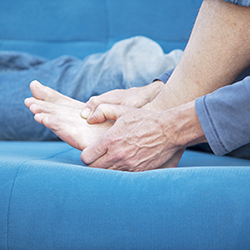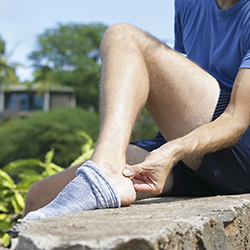Our Services
Paul Savage and Associates are specialists in advanced podiatric treatments including nail surgery, biomechanical assessment, and verrucae removal. In addition to these specialist treatments, we also provide routine chiropody and footcare services in our Sunderland-based podiatry practice.
As a fully accredited provider of NHS podiatric services, Paul Savage and Associates also offer the select procedures available on the NHS.
For details of the treatments available through the NHS click here.
Please note that to access these services patients will first need to visit their GP to be referred to our practice for treatment.
We offer a full range of foot treatments:
Corns and Calluses (Routine Chiropody)
Corns and calluses occur as a reaction of the skin to the pressures on it. Sometimes this is pressure from shoes, sometimes there is a structural or functional cause. Corns and calluses can be painlessly removed. More importantly, the Podiatrist can give advice or provide treatment to target the cause and aim to prevent further recurrence.
Nail Surgery
Ingrowing toenails can occur when a nail has been damaged or is deformed. The nail grows into the skin causing pain and sometimes leading to infection. This condition can be treated conservatively, but surgery may be necessary to prevent recurrence. Surgery is performed under local anaesthesia. Usually only part of the offending nail is removed, although it is possible to remove the whole nail if it is very deformed.
Verrucae Removal
Verrucae are caused by a viral infection. In most cases the verruca is painless and, given time, will resolve without treatment. Painful or spreading verrucae can however cause distress. A wide range of verrucae treatments are available including Cryosurgery (freezing), traditional acid treatments, herbal remedies, low level laser therapy and surgical removal.The treatment of choice will depend on a variety of factors and the options are discussed in detail to enable an informed choice.
Biomechanics and Orthoses
A biomechanical examination is used to assess foot and lower limb function. Foot pain can be caused by poor foot posture or other structural problems. Common problems include heel pain, pain in the ball of the foot (metatarsalgia) and flat feet. If the foot is hypermobile or out of alignment it can result in pain or injury in the foot/knee/hip/lower back.
Orthoses are 3-Dimensional insoles that control the way the foot functions therefore keeping it in better alignment. These may be issued "off the shelf" with a generic prescription or custom made to fit and correct the foot more accurately.
Diabetic Footcare
People diagnosed with diabetes can develop foot complications including loss of sensation in the feet. This can result in damage that you may be unaware of e.g. standing on a sharp object or a toenail digging in. People with diabetes should have annual foot assessments to monitor any loss of sensation. Numb feet should be always protected and checked regularly for damage. Diabetes can also affect the blood supply to the feet, causing a delay in the healing of any wound and increasing the risk of infection. The circulation to the feet is also checked during a diabetic foot assessment.
Athlete’s Foot
Athlete’s foot is caused by a fungal infection and is characterized by itching, cracked or peeling skin. Although it is frequently found between the toes it can also occur on dry skin elsewhere on the foot. Athlete’s foot is usually treated with antifungal creams or sprays. If left untreated the fungus can spread to the toenails. The nails become thickened and yellow and this infection may be more difficult to treat.
Nail cutting service
Our Podiatry Assistant provides an economy toenail cutting service for those with normal toenails but who cannot reach their feet. This service is subject to assessment by the Podiatrist and there are exceptions for some with medical conditions.





